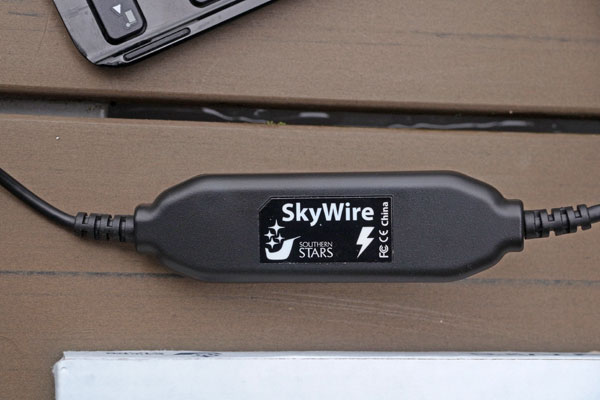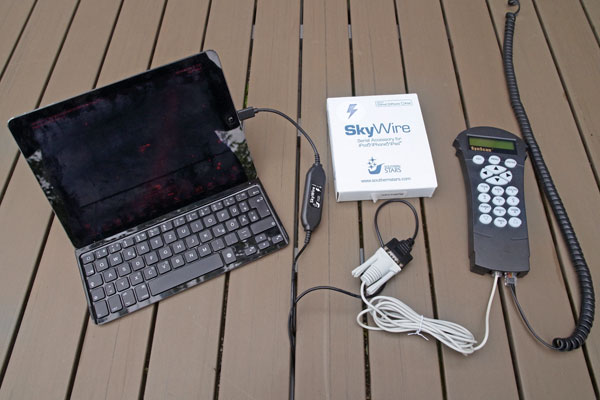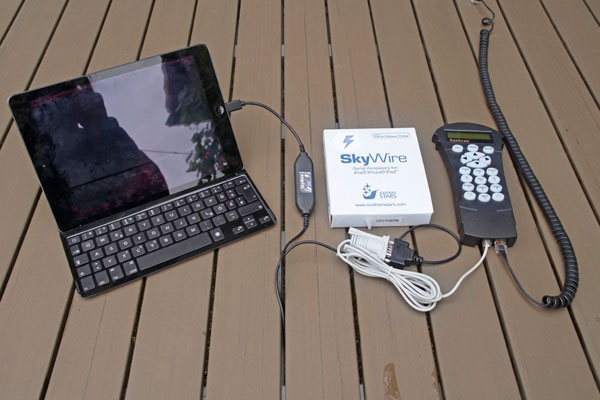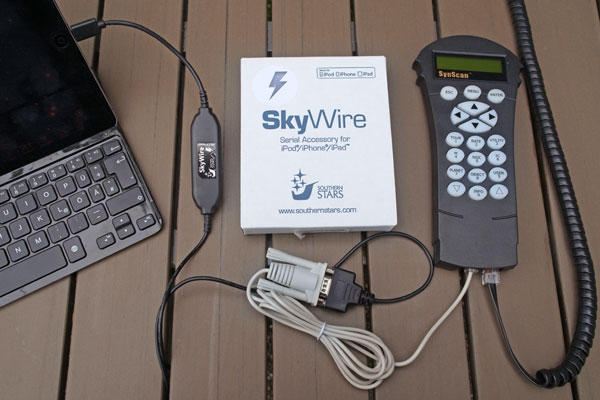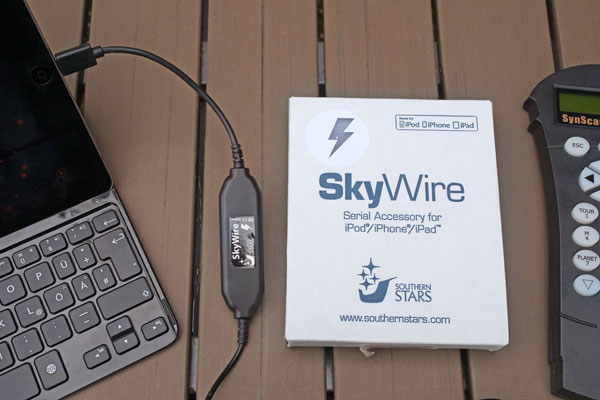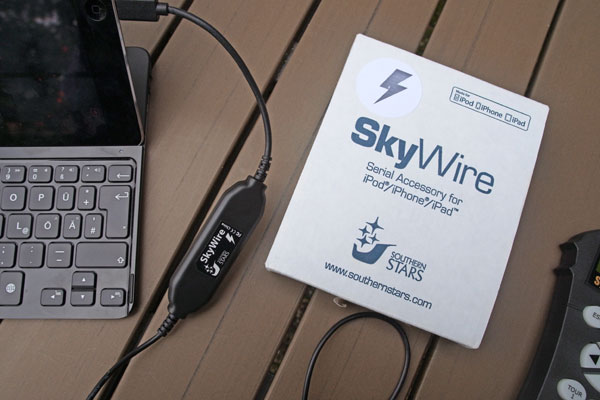Simulation Curriculum SkyWire Information
Introduction | Look | Experiences | Conclusions | Links
Archive
On this page, I present some information about the SkyWire Serial Accessory developed by Southern Stars for Simulation Curriculum and, in the meantime (purchased in July 2016), distributed and serviced only by the latter company. I bought the version with Lightning connector for newer iPads and iPhones. This device allows me to control my Sky-Watcher Star Discovery AZ GoTo telescope mount with the iPad astronomy app SkySafari Pro instead of using the hand box (the hand box is still needed, though, for example, for the alignment). For this purpose, the device has to be connected to the RS232 interface of the hand box.
Note that there is also a WiFi version of this device that is called SkyFi 3 (current version; or III...). On the other hand, Sky-Watcher also offers a WiFi adapter for most of its GoTo mounts and telescope called SynScan WLAN. This device is, however, controlled using the SynScan app and not primarily designed for being used with SkySafari (read on the respective page for details on this topic).
| Note: I gave away the SkyWire device at the beginning of May 2019 and therefore cannot report any new information here. |
See also:
- Sky-Watcher SynScan WLAN Information Archive
- Celestron StarSense AutoAlign for Sky-Watcher Information Archive
- Sky-Watcher SynScan WLAN - First Experiences Archive
- Sky-Watcher SynScan WLAN - Further Experiences Archive
- Celestron StarSense AutoAlign for Sky-Watcher - First Experiences Archive
- Celestron StarSense AutoAlign for Sky-Watcher - Further Experiences Archive
Introduction
Originally, I intended to use the Star Discovery GoTo mount only with the SynScan hand box, even though I knew that controlling the telescope using astronomy software applications such as Stellarium is possible with the Star Discovery mount. However, an RS232 to USB adapter is required to connect the hand box to the computer, but it is not guaranteed that such an adapter will work on the Apple Macintosh. So I did my first attempts on using GoTo with the SynScan hand box. This succeeded fairly well, but I am not a friend of this kind of interaction and - quite in contrast to controlling telescopes using astronomy apps - I find hand boxes rather counter-intuitive to use.
I accidentally came across SouthernStars' SkyFi WiFi telescope control accessory* (built for Simulation Curriculum, the developers of the Starry Night and SkySafari astronomy applications who now also distribute the device), which seemed too expensive for me. But then I discovered that there is also a wired solution for the iPad from SouthernStars, the considerably cheaper SkyWire Serial Accessory (unfortunately it does not work with the MacBook ...). This device is available in two versions, a cheaper one for the old 30-pin connector and a slightly more expensive one for the Lightning connector. Since my iPad sports a Lightning connection, I would have needed an adapter for the cheaper version. But this combination would be priced similarly to the Lightning version - and would include a potentially wobbly adapter. So I finally decided to buy the Lightning version of the SkyWire device, because I was curious to learn how controlling a telescope using an astronomy app does work.
*) Note: The SkyFi and SkyWire telescope control accessories are now owned and supported by Simulation Curriculum Corporation. Contact Simulation Curriculum for technical support on these products (from: www.southernstars.com/products/index.html).
Look
|
Southern Stars SkyWire Serial Accessory |
Ditto connected to iPad and hand box |
Ditto |
|
Ditto, detail |
Ditto |
Ditto |
Experiences
One advantage of SkyWire compared to SkyFi is that it does not need any power supply. Its drawback is that it is connected to the iPad via a cable. This means that the device can not be positioned at will, and in the dark the cable is also a potential stumbling block.
All in all, I made only a few experiences with SkyWire, but I can report that the setup is hassle-free (the alignment has, however, to be done with the handbox at first), and controlling the telescope works well: You simply point at the position in the sky where you want the telecope to go to. SkySafari shows the position in the sky where the telescope points to, and this can be visualized (and customized) in a number of ways. SkyWire can be "autodetected" by the SkySafari application and is better supported than the Sky-Watcher WiFi solution.
Alignment Correction
If the deviations from the target are not too large, the telescope position can be corrected using the "Align" command in the Scope Control panel so that the to be observed object is indeed approached - and not a point in its vicinity. Sometimes, however, the deviation was too large for a correction and an error message appeared. Then, however, I mostly (not always...) managed to approach the target step by step, while updating the position in SkySafari using the "Align" command.
Note: Probably, I had misunderstood the way how the "Align" function works, as was suggested to me when I later read the help information for this function. Below, there is an excerpt from the Help on this topic (with my own additions).
Align: This synchronizes the scope to coordinates of the selected object. The bullseye indicated in the sky chart shows where the telescope thinks it is pointing. If that appears incorrect, the scope and the software must be aligned. To do so:
- Physically center the scope on a real object in the sky (do not use the arrow keys in SkySafari or on the handbox!).
- Select that object in the sky chart to make it the current target object.
- Click the Align button.
You can re-align the scope and the software anytime there is a discrepancy between the two. (Sometimes, however, an error message appears that the difference is too large, but this may only appear if you move the scope with the motors.)
It is important that you disable the help encoders in the mount (if there are such...). Otherwise, the purely mechanical movement of the mount would also be recognized and registered by SkySafari. When using the SynScan handbox the encoders are enabled by default.
Note: for Celestron NexStar, Orion/SkyWatcher SynScan, iOptron GOTONova, and ServoCAT telescope controllers, tapping the Align button stores the offset between the telescope's reported position and the selected object's position. It subtracts that offset from the telescope's reported position whenever the telescope is within 10 degrees of the object you Aligned on. In other words, SkySafari performs a "local sync" around the alignment target. If you move the telescope to a very different part of the sky, you may want to Align on a target in that part of the sky. Also note that the telescope's RA/Dec reported by SkySafari will differ from the RA/Dec reported by its hand controller (since SkySafari is applying the alignment offset to the telescope's reported position.)
Conclusions
Basically, the device works seamlessly together with the Star Discovery mount and the SkySafari application on the iPad. However, I find the cable connection annoying, as it prevents me from being able to quickly put the iPad down somewhere. Often, I put it just on the floor, which is not the optimum...
I also do not know why you cannot perform the star alignment with SkySafari, but have to use the hand control for this. The possibility to improve the alignment by approaching the target object and calling the "Align" function in SkySafari is welcome, but unfortunately only works if the deviations are not too large and often requires an iterative "approaching" to the target.
Since the SkyWire serial accessory is basically only an RS232 to USB adapter, I find the device over-priced. Unfortunately you cannot use alternative adapters, because the Apple guidelines require that SkySafari works ONLY with SkyWire. Thank you Apple!
Otherwise, I find controlling the telescope with SkyWire and SkySafari very pleasant and comfortable. However, I would prefer an equivalent wireless controller. Unfortunately, SkyFi 3 is much too expensive for me. The SynScan WLAN control by Sky-Watcher is considerably cheaper, and I therefore acquired it as well. It has, however, its own problems, which are described elsewhere. But after a few weeks I was able to overcome most of these issues, and I therefore decided to part with the SkyWire serial accessory at the beginning of May 2019.
| Note: I gave away the SkyWire device at the beginning of May 2019 and therefore cannot report any new information here. |
Links
- SkyWire Serial Accessory: www.skysafariastronomy.com/products/skywire/index.html
- SkyWire Lightning Serial Accessory: store.simulationcurriculum.com/collections/frontpage/products/skywire-lightning-serial-accessory
- SkyWire Serial Accessory: www.teleskop-express.de/shop/product_info.php/language/en/info/p6526_SouthernStars-SkyWire---GOTO-mit-iPhone-5-und-SkySafari-Pro---Lightning-Anschlu-.html
- SkyFi 3: skysafariastronomy.com/skyfi-3-professional-astronomy-telescope-control.html
- SkyFi III Wireless Scope Control Package: store.simulationcurriculum.com/collections/frontpage/products/skyfi-iii-wireless-scope-control-package
| 04.12.2024 |
